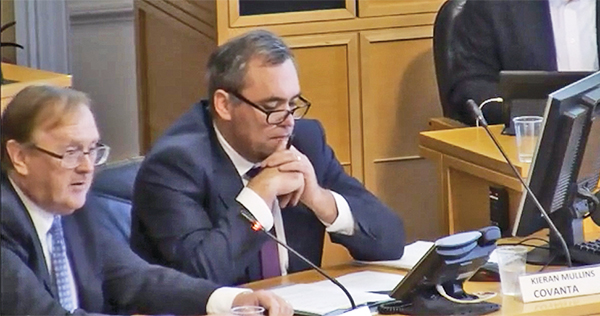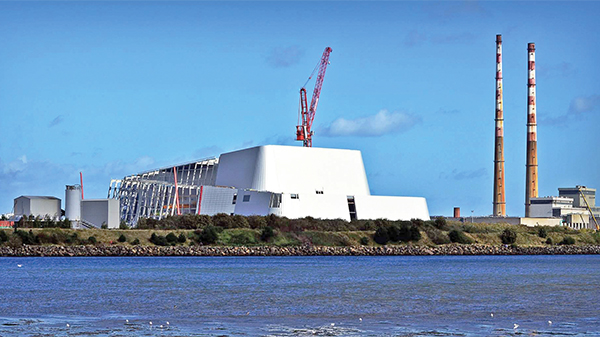
Pictured: John Daly and Kieran Mullins of Covanta.
Image courtesy of DCC.
The joint partnership between Covanta and Dublin City Council (DCC) has long been controversial, Widely opposed by locals and most councillors, it will cost approximately €600 million. It will likely burn waste for all of Leinster and beyond and if the waste quota is not reached the DCC must pay penalties to Covanta.
Significantly Covanta, who are highly taciturn when it comes to giving information about their plans, agreed to attend a special meeting of the Environment Strategic Planning Committee on December 8th.
There was tension between Covanta and other members of the committee, despite the forced politeness. The issue at the heart of the controversy has changed. Joe McCarthy of An Taisce accepts that the incinerator is going ahead. It has become a strategy of damage mitigation. McCarthy states that the best scenario would be to have no incinerator; saving that a well-monitored incinerator would be the lesser evil.
However, obtaining Covanta’s commitment to provide the emissions data necessary for such monitoring was a frustrating effort by McCarthy and Cllr Mannix Flynn during a special meeting of the Environment Strategic Planning Committee. Covanta Ireland MD, John Daly, stuck by the mantra that the EPA license regarding pollution was all they needed to adhere to in terms of weekly monitoring to the EPA.
They have stated that they will provide monthly and, in some cases, bi-annual monitoring on their website. This was in sharp contrast to McCarthy’s view that they should provide continuous data on their emissions, to the public. Technically, Covanta are firewalled from meticulous scrutiny as the license does not have very strict guidelines.
The crucial point that Covanta did not adequately respond to is the fact that they have failed ‘stack tests’ in Durham Yorke (their new incinerator in Ontario, Canada), in what appears to be their first fully designed and operational plant.
In another incinerator operation they were involved in, Miami-Dade, (USA) they did not inject enough carbon into their stack, a critical error McCarthy suspects they repeated in Durham Yorke. Covanta argued that they had remedied both situations and that they were not deliberate transgressions.
However, it begs the question as to why they were not forced to be more strictly monitored in the license agreement in Ireland, given the fact that some of their data is too infrequent to accurately show their emissions. For example, McCarthy pointed out that the data, which is weekly instead of daily would be infrequent enough to disguise figures.
Worryingly, Covanta has not appointed the independent firm who will be monitoring their emissions data, despite the fact that it takes up to six weeks to prepare adequately for such monitoring, according to McCarthy. Indeed, they have not appointed the company that will verify their engineering in the plant itself. Despite assurances of being open, “not in the business of manipulating data,” it took a Freedom of Information request on McCarthy’s part to receive the plan they had submitted to the EPA. A plan, which he asserted was not detailed and differed from the presentation to the Committee.
This issue of monitoring is not just present purely in terms of emissions, though that is a significant issue. It goes deeper than that. It is certainly the case that Covanta are hard to reach and do not give much information away.

Pictured: The incinerator. How strictly will its emissions be monitored?
Photo by Kevin O’ Gorman.
This leads to the heart of the issue with the Poolbeg facility. Who is the watchman? Who makes sure that Covanta under the auspices of Dublin Waste to Energy Ltd carries out their function with minimal impact to environment and public health? Is it Dublin City Council elected councillors? Is it the Environment Strategic Committee? Is it the Dublin City Council Executive? Certainly, it cannot be the EPA as Covanta assert as they have no legal arm to enforce anything other than to ensure that the license is followed. A license that does not require sufficiently frequent emissions testing and that does not have special concern for activated carbon.
Clearly it is not being adequately enforced, as standard procedures involving establishing engineering oversight are now severely behind and as it stands, Covanta has given little evidence they will be any more forthcoming with emissions. They stated that they would look into giving more detail to the committee after they were asked to by the chairperson.
By Kevin Mac Sharry



